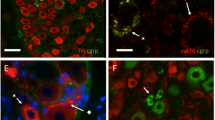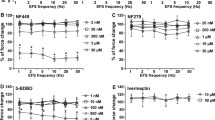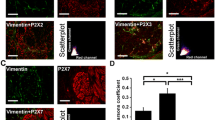Abstract
Purinergic P2X receptors associated with the parasympathetic nerves supplying human bladder smooth muscle (detrusor) are implicated in control of detrusor contractility. The relative abundance of all seven subtypes colocalised with synaptic vesicles on parasympathetic nerves was examined in specimens from normal adult bladder and in adults with the urodynamics findings of sensory urgency (SU) to determine how receptor distribution varied in patients with a small bladder capacity. Alteration in control of detrusor innervation was examined with P2X subtype-specific antibodies and an antibody (SV2) against synaptic vesicles, using immunofluorescence and confocal microscopy. Detrusor samples were taken from: controls, at cystectomy for cancer or cystoscopic biopsy for haematuria (n=22, age 33–88 years) and adults with sensory urgency at cystoscopy/cystodistension (n=11, age 37–70 years). Normal adult specimens contained detrusor muscle innervated by parasympathetic nerves possessing large varicosities (1.2 μm) distributed along their length. These mostly all showed colocalised patches of presynaptic P2X1,2,3,5 subtypes while presynaptic subtypes P2X4,6,7 were present in only 6–18% of varicosities. Detrusor nerve varicosities from SU patients revealed general loss of all presynaptic P2X subtypes with the proportion containing receptors reducing to only 0.5–5% depending on P2X subtype. The same loss was recorded from the sensory nerves in the surrounding lamina propria. This specific loss of P2X receptors may impair control of detrusor distension and contribute to the pathophysiology of sensory urgency.



Similar content being viewed by others
References
Abrams P (1997) Patient assessment. In: Urodynamics, Chap 4. Springer, London, pp 127–129
Abrams P, Cardozo L, Fall M, Griffiths D, Rosier P, Ulmsten U, van Kerrebroeck P, Victor A, Wein A (2002) The standardisation of terminology of lower urinary tract function: report from the standardisation sub-committee of the International Continence Society. Neurourol Urodyn 21:167–178
Barajas-Lopez C, Espinosa-Luna R, Zhu Y (1998) Functional interactions between nicotinic and P2X channels in short-term cultures of guinea-pig submucosal neurons. J Physiol (Lond) 513:671–683
Barden JA, Cottee LJ, Bennett MR (1999) Vesicle-associated proteins and P2X receptor clusters at single sympathetic varicosities in mouse vas deferens. J Neurocytol 28:469–480
Barden JA, Sluyter R, Gu BJ, Wiley JS (2003) Specific detection of non-functional P2X7 receptors in HEK293 cells and B-lymphocytes. FEBS Lett 538:159–162
Bayliss M, Wu C, Newgreen D, Mundy AR, Fry CH (1999) A quantitative study of atropine-resistant contractile responses in human detrusor smooth muscle, from stable, unstable and obstructed bladders. J Urol 162:1833–1839
Bo X, Burnstock G (1995) Characterization and autoradiographic localisation of [3H] alpha, beta-methylene adenosine 5’-triphosphate binding sites in human urinary bladder. Br J Urol 76:297–302
Boehm S (1999) ATP stimulates sympathetic transmitter release via presynaptic P2X purinoceptors. J Neurosci 19:737–746
Bolego C, Pinna C, Abbracchio MP, Cattabeni F, Puglisi L (1995) The biphasic response of rat vesical smooth muscle to ATP. Br J Pharmacol 114:1557–1562
Bower WF, Moore KH, Shepherd RB, Adams R (1996) The epidemiology of childhood enuresis in Australia. Br J Urol 78:602–606
Brading AF, Inoue R (1991) Ion channels and excitatory transmission in the smooth muscle of the urinary bladder. Zeit Kardiol 80 (Suppl 7):47–53
Brown C, Burnstock G, Cocks T (1979) Effects of adenosine 5’-triphosphate (ATP) and β, γ-methylene ATP on the rat urinary bladder. Br J Pharmacol 65:97–102
Burnstock G, Cocks T, Kasakov L, Wong HK (1978) Direct evidence for ATP release from non-adrenergic, non-cholinergic (“purinergic”) nerves in the guinea-pig taenia coli and bladder. Eur J Pharmacol 49:145–149
Cockayne DA, Hamilton SG, Zhu Q-M, Dunn PM, Zhong Y, Novakovic S, Malmberg AB, Cain G, Berson A, Kassotakis L, Hedley L, Lachnit WG, Burnstock G, McMahon SB, Ford APDW (2000) Urinary bladder hyporeflexia and reduced pain-related behaviour in P2X3-deficient mice. Nature 407:1011–1015
Dutton JE, Hansen MA, Barden JA, Bennett MR (1999) Development of the distribution of single P2X homomeric and heteromeric receptor clusters on smooth muscle cells in relation to nerve varicosities in the rat urinary bladder. J Neurocytol 28:3–15
Evans RJ, Lewis C, Virginio C, Lundstrom K, Buell G, Surprenant A, North RA (1996) Ionic permeability of, and divalent cation effects on, two ATP-gated cation channels (P2X receptors) expressed in mammalian cells. J Physiol 497:413–422
Gosling JA, Dixon JS (1975) The structure and innervation of smooth muscle in the wall of the bladder neck and proximal urethra. Br J Urol 47:549–558
Hansen MA, Balcar VJ, Barden JA, Bennett MR (1998) The distribution of single P2X1-receptor clusters on smooth muscle in relation to nerve varicosities in the rat urinary bladder. J Neurocytol 27:529–539
Hay-Smith J, Herbison P, Ellis G, Moore K (2002) Anticholinergic drugs versus placebo for overactive bladder syndrome in adults. Cochrane Database Syst Rev 3:CD003781
Hunskar S, Arnold EP, Burgio K, Diokno AC, Herzog AR, Mallett VT (2000) Epidemiology and natural history of urinary incontinence: review article. Int Urogynacol J 11:301–319
Kukley M, Barden JA, Steinhäuser C, Jabs R (2001) Distribution of P2X receptors on astrocytes in juvenile rat hippocampus. Glia 36:11–21
Lee H, Bardini M, Burnstock G (2000) Distribution of P2X receptors in the urinary bladder and the ureter of the rat. J Urol 163:2002–2007
Longhurst PA, Schwegel T, Folander K, Swanson R (1996) The human P2X1 receptor: molecular cloning, tissue distribution, and localisation to chromosome 17. Biochim Biophys Acta 1308:185–188
Moore KH (1999) Detrusor instability in the female: controversies in diagnosis, etiology and management. Crit Rev Phys Rehab Med 11:35–61
Moore KH, Gilpin SA, Dixon JS, Richmond DH, Sutherst JR (1992) An increase of presumptive sensory nerves of the urinary bladder in idiopathic detrusor instability. Br J Urol 70:370–372
Moore KH, Ray FR, Barden JA (2001) Loss of purinergic P2X3 and P2X5 receptor innervation in human detrusor from adults with urge incontinence. J Neurosci 21:U17–U22
Nakazawa K (1998) ATP-activated current and its interaction with acetylcholine-activated current in rat sympathetic neurons. J Neurosci 14:740–750
O’Reilly BA, Kosaka AH, Chang TK, Ford APDW, Popert R, McMahon SB (2001) A quantitative analysis of purinoceptors expression in the bladders of patients with symptomatic outlet obstruction. BJU Int 87:617–622
O’Reilly BA, Kosaka AH, Knight GF, Chang TK, Ford APDW, Rymer JM, Popert R, Burnstock G, McMahon SB (2002) P2X receptors and their role in female idiotypic detrusor instability. J Urol 167:157–164
Searl TJ, Redman RS, Silinsky EM (1998) Mutual occlusion of P2X ATP receptors and nicotinic receptors on sympathetic neurons of the guinea-pig. J Physiol (Lond) 510:783–791
Smet P, Moore KH, Jonavicius J (1997) Distribution and colocalisation of calcitonin gene-related peptide, tachykinins, and vasoactive intestinal peptide in normal and idiopathic unstable human urinary bladder. Lab Invest 77:37–49
Sperlagh B, Erdelyi F, Szabo G, Vizi ES (2000) Local regulation of [3H]-noradrenaline release from the isolated guinea-pig right atrium by P2X-receptors located on the axon terminals. Br J Pharmacol 131:1775–1783
Tagliani M, Candura SM, Di Nucci A, Franceschett GP, D’Agostino G, Ricotti P, Fiori E, Tonini M (1997) A re-appraisal of the nature of the atropine-resistant contraction to electrical field stimulation in the human isolated detrusor muscle. Naunyn Schmiedebergs Arch Pharmacol 356:750–755
Theobald RJ Jr (1995) Purinergic and cholinergic components of bladder contractility and flow. Life Sci 56:445–454
Yunaev MA, Barden JA, Bennett MR (2000) Changes in the distribution of different subtypes of P2X receptor clusters on smooth muscle cells in relation to nerve varicosities in the pregnant rat urinary bladder. J Neurocytol 29:99–108
Zhou X, Galligan JJ (1998) Non-additive interaction between nicotinic cholinergic and P2X purine receptors in guinea-pig enteric neurons in culture. J Physiol (Lond) 513:685–697
Author information
Authors and Affiliations
Corresponding author
Additional information
The study was funded by the National Health and Medical Research Council of Australia
Rights and permissions
About this article
Cite this article
Ray, F.R., Moore, K.H., Hansen, M.A. et al. Loss of purinergic P2X receptor innervation in human detrusor and subepithelium from adults with sensory urgency. Cell Tissue Res 314, 351–359 (2003). https://doi.org/10.1007/s00441-003-0788-z
Received:
Accepted:
Published:
Issue Date:
DOI: https://doi.org/10.1007/s00441-003-0788-z




